
The caddisflies, or order Trichoptera, are a group of insects with aquatic larvae and terrestrial adults. There are approximately 14,500 described species, most of which can be divided into the suborders Integripalpia and Annulipalpia on the basis of the adult mouthparts. Integripalpian larvae construct a portable casing to protect themselves as they move around looking for food, while annulipalpian larvae make themselves a fixed retreat in which they remain, waiting for food to come to them. The affinities of the small third suborder Spicipalpia are unclear, and molecular analysis suggests it may not be monophyletic. Also called sedge-flies or rail-flies, the adults are small moth-like insects with two pairs of hairy membranous wings. They are closely related to the Lepidoptera which have scales on their wings; the two orders together form the superorder Amphiesmenoptera.
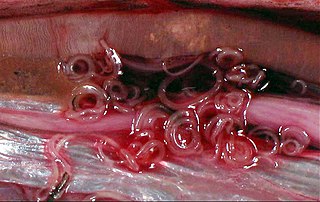
The order Ascaridida includes several families of parasitic roundworms with three "lips" on the anterior end. They were formerly placed in the subclass Rhabditia by some, but morphological and DNA sequence data rather unequivocally assign them to the Spiruria. The Oxyurida and Rhigonematida are occasionally placed in the Ascaridida as superfamily Oxyuroidea, but while they seem indeed to be Spiruria, they are not as close to Ascaris as such a treatment would place them. These "worms" contain a number of important parasites of humans and domestic animals.

Tineoidea is the ditrysian superfamily of moths that includes clothes moths, bagworms and relatives. There are six families usually included within it, Eriocottidae, Arrhenophanidae, Lypusidae, Acrolophidae, Tineidae and Psychidae, whose relationships are currently uncertain.

The Lonchopteridae are a family of small (2–5 mm), slender, yellow to brownish-black Diptera, occurring all over the world. Their common name refers to their pointed wings, which have a distinct venation. Many are parthenogenic; males are very rare, however, at least in North American species, and have a somewhat different venation than do the females.

The Gerromorpha comprise an infraorder of insects in the "true bug" order Hemiptera. These "typical" bugs are commonly called semiaquatic bugs or shore-inhabiting bugs. The Ochteroidea (infraorder Nepomorpha are also found in shore habitat, while the Gerromorpha are actually most often encountered running around on the water surface, being kept from sinking by surface tension and their water-repellent legs. Well-known members of the Gerromorpha are the namesake Gerridae.

The Pentatomomorpha comprise an infraorder of insects in the true bug order Hemiptera. It unites such animals as the stink bugs (Pentatomidae), flat bugs (Aradidae), seed bugs, etc. They are closely related to the Cimicomorpha.
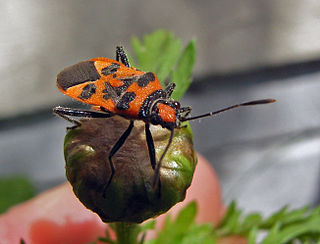
Coreoidea is a superfamily of true bugs in the infraorder Pentatomomorpha which includes leaf-footed bugs and allies. There are more than 3,300 described species in Coreoidea.
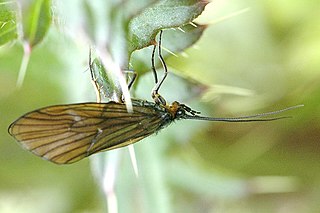
Limnephiloidea is a superfamily of Trichoptera caddisflies.

The Brachyceran infraorder Muscomorpha is a large and diverse group of flies, containing the bulk of the Brachycera and most of the known flies. It includes a number of the most familiar flies, such as the housefly, the fruit fly, and the blow fly. The antennae are short, usually three-segmented, with a dorsal arista. Their bodies are often highly setose, and the pattern of setae is often taxonomically important.
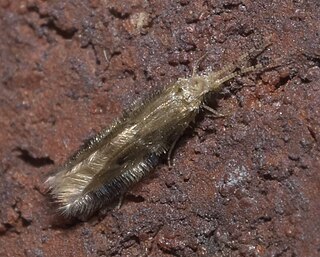
The Hydroptilidae are a large family of caddisflies (Trichoptera) with a worldwide distribution. They are commonly known as microcaddisflies or purse-case caddisflies, in reference to two characteristic traits of this family: Hydroptilidae are much smaller than other caddisflies, rarely exceeding 5 mm (0.20 in) in length. Their larvae do not build a protective case until the final instar of their growth. At that time however, they build a typically Purse-shaped case, either portable or stuck to the substrate, in which the larva finishes growth and pupates.

Histeroidea is a superfamily of beetles in the infraorder Staphyliniformia.
The Glossosomatidae are a family of the class Insecta and order Trichoptera.The family contains 23 genera in three subfamilies. In the US alone, there are 76 spp. in 6 different genera.
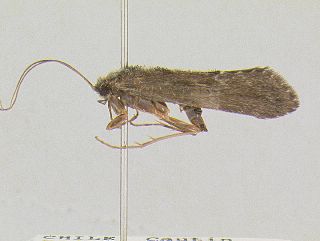
The Hydrobiosidae are a family of caddisflies in the insect order Trichoptera. The family contains two subfamilies with about 50 genera.

Spirurida is an order of spirurian nematodes. Like all nematodes, they have neither a circulatory nor a respiratory system.

Diplogasterida was an order of nematodes. It was sometimes placed in a monotypic subclass Diplogasteria, but molecular phylogenetic evidence has shown it to be embedded in the family Rhabditidae. The confusion of having a hierarchical nesting of groups that were formerly mutually exclusive has led to a profusion of names. Although completely revised taxonomy of nematodes that builds on recent classification systems as well as recent phylogenetic evidence is still necessary, most contemporary taxonomic studies now treat all groups listed under "Diplogasterina" below as a single family, Diplogastridae.

Prostigmata is a suborder of mites belonging to the order Trombidiformes, which contains the "sucking" members of the "true mites" (Acariformes).

Dysoneuridae is an extinct family of insect in the order Trichoptera, the caddisflies. The family was first described by I.D. Sukacheva in 1968, and lived from the Middle Jurassic to mid-Cretaceous.
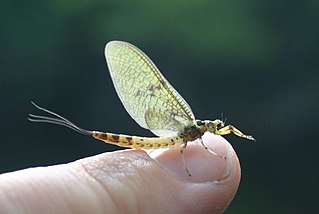
Ephemeroidea is a superfamily of mayflies. Members of this superfamily are found in most parts of the world with the exception of the Arctic, the Antarctic and Australia.
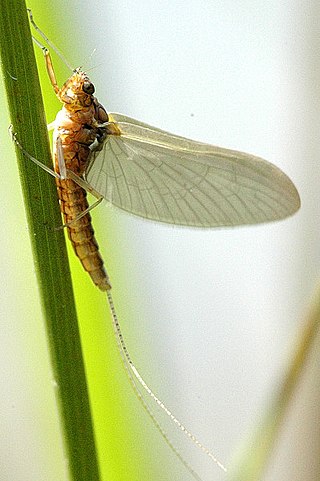
Pannota is a suborder of mayflies. One of the differences between this suborder and its sister group Schistonota concerns the degree of fusion of the wing pads in the final-stage nymph; in Schistonota, the degree of fusion along the mesothorax is more than half the fore-wing length while in Pannota the degree of fusion is less than half that length. Other differences between the two groups include the morphology of the gills and also behavioural differences. Schistonota nymphs are mostly active swimmers, burrowers and sprawlers, while Pannota nymphs are more passive, slow-moving crawlers.

Hymenopterida is a superorder of holometabolous (metamorphosing) insects. As originally circumscribed, it included Hymenoptera and the orders in Panorpida. However, more recent studies find Hympenoptera as sister to the other members of Holometabola and the superorder is restricted to Hymenoptera.



















